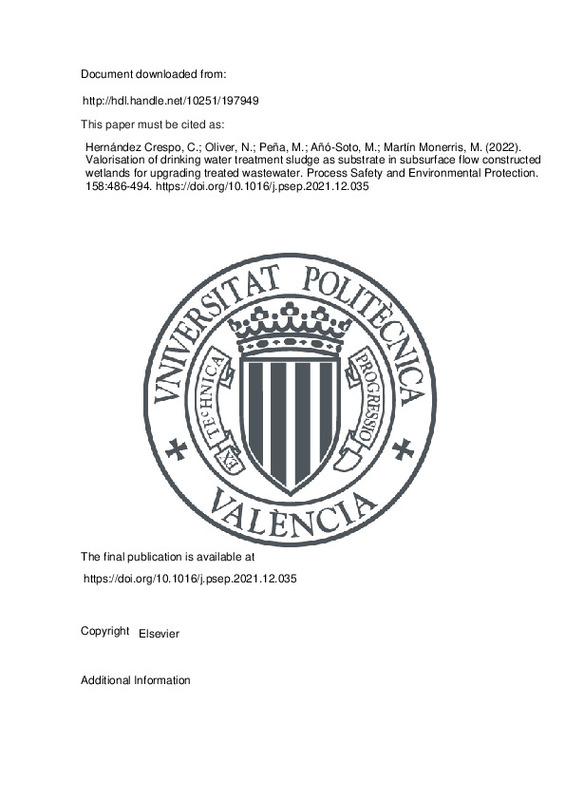JavaScript is disabled for your browser. Some features of this site may not work without it.
Buscar en RiuNet
Listar
Mi cuenta
Estadísticas
Ayuda RiuNet
Admin. UPV
Valorisation of drinking water treatment sludge as substrate in subsurface flow constructed wetlands for upgrading treated wastewater
Mostrar el registro sencillo del ítem
Ficheros en el ítem
| dc.contributor.author | Hernández Crespo, Carmen
|
es_ES |
| dc.contributor.author | Oliver, Núria
|
es_ES |
| dc.contributor.author | Peña, María
|
es_ES |
| dc.contributor.author | Añó-Soto, Miguel
|
es_ES |
| dc.contributor.author | Martín Monerris, Miguel
|
es_ES |
| dc.date.accessioned | 2023-10-10T18:02:08Z | |
| dc.date.available | 2023-10-10T18:02:08Z | |
| dc.date.issued | 2022-02 | es_ES |
| dc.identifier.issn | 0957-5820 | es_ES |
| dc.identifier.uri | http://hdl.handle.net/10251/197949 | |
| dc.description.abstract | [EN] Drinking water treatment sludge (DWTS) is the main waste produced in drinking water treatment plants (DWTPs). Its valorisation as substrate for constructed wetlands (CWs) aimed at upgrading treated urban wastewater is presented. Keeping a holistic approach in mind, this study looks for nutrient and organic matter removal but also contaminants of emerging concern (CECs) and pathogens. Three pilot subsurface flow CWs (1 m2) were installed under outdoor conditions in real WWTPs. Different operation modes (sequential: S-CW and continuous saturated flow: C-CW, CC-CW), different nutrient influent concentrations (SCW and C-CW: 0.6 mg TP/l, 12.7 mg TN/l; CC-CW: 6.5 mg TP/l, 48 mg TN/l) and high hydraulic loading rates (HLRs, 0.9-5.1 m3/m2/d) were tested. C-CW presented higher removal efficiencies than S-CW for TP (C-CW: 56-86%; S-CW: 32-66%), total nitrogen (C-CW: 23-38%; S-CW: -3 to 6%) and E. coli (C-CW: 94%; S-CW: 84%), while S-CW performed better for ammonium (C-CW: 29-45%; S-CW: 72-86%) and CECs removal. Among fifteen CECs monitored, most pharmaceuticals, four were significantly reduced in C-CW and nine in S-CW, which had more aerobic conditions. CC-CW reduced nutrients and organic matter by 62% (TP), 8% (TN), 23% and 40% (chemical and biochemical oxygen demands, respectively). The potential release of aluminium was negligible. Novel values for the first-order reaction coefficient of P-k-C* model are provided for the TP removal process using DWTS (0.6-1.0 h-1). The main conclusion is that DWTS is a suitable substrate to significantly upgrade WWTP effluents, even at high HLRs. A hybrid system combining sequential and continuous flow modes could optimize the upgrading treatment. A proposal for the full valorisation of the sludge produced in one DWTP is presented. (c) 2021 Institution of Chemical Engineers. Published by Elsevier B.V. All rights reserved. | es_ES |
| dc.description.sponsorship | The authors thank the partial funding by the Generalitat Valenciana-IVACE (Valencian Institute of Business Competitiveness) and the European Regional Development Fund (through the ERDF Operational Program for the Valencian Community 2014-2020). The authors also thank the Public Entity for Wastewater Sanitation of the Valencian Community (EPSAR), attached to the Conselleria de Agricultura, Desarrollo Rural, Emergencia Climatica y Transicion Ecologica. As well as the Cathedra "Aguas de Valencia-Universitat Politecnica de Valencia", Department of Hydraulic Engineering and the Environment. | es_ES |
| dc.language | Inglés | es_ES |
| dc.publisher | Elsevier | es_ES |
| dc.relation.ispartof | Process Safety and Environmental Protection | es_ES |
| dc.rights | Reconocimiento - No comercial - Sin obra derivada (by-nc-nd) | es_ES |
| dc.subject | Alum sludge | es_ES |
| dc.subject | Treatment wetlands | es_ES |
| dc.subject | Emerging pollutants | es_ES |
| dc.subject | Upgrading treatment | es_ES |
| dc.subject | Phosphorus removal | es_ES |
| dc.subject | Pathogens removal | es_ES |
| dc.subject.classification | TECNOLOGIA DEL MEDIO AMBIENTE | es_ES |
| dc.title | Valorisation of drinking water treatment sludge as substrate in subsurface flow constructed wetlands for upgrading treated wastewater | es_ES |
| dc.type | Artículo | es_ES |
| dc.identifier.doi | 10.1016/j.psep.2021.12.035 | es_ES |
| dc.rights.accessRights | Abierto | es_ES |
| dc.contributor.affiliation | Universitat Politècnica de València. Escuela Técnica Superior de Ingenieros de Caminos, Canales y Puertos - Escola Tècnica Superior d'Enginyers de Camins, Canals i Ports | es_ES |
| dc.description.bibliographicCitation | Hernández Crespo, C.; Oliver, N.; Peña, M.; Añó-Soto, M.; Martín Monerris, M. (2022). Valorisation of drinking water treatment sludge as substrate in subsurface flow constructed wetlands for upgrading treated wastewater. Process Safety and Environmental Protection. 158:486-494. https://doi.org/10.1016/j.psep.2021.12.035 | es_ES |
| dc.description.accrualMethod | S | es_ES |
| dc.relation.publisherversion | https://doi.org/10.1016/j.psep.2021.12.035 | es_ES |
| dc.description.upvformatpinicio | 486 | es_ES |
| dc.description.upvformatpfin | 494 | es_ES |
| dc.type.version | info:eu-repo/semantics/publishedVersion | es_ES |
| dc.description.volume | 158 | es_ES |
| dc.relation.pasarela | S\453452 | es_ES |
| dc.contributor.funder | European Regional Development Fund | es_ES |
| dc.contributor.funder | Institut Valencià de Competitivitat Empresarial | es_ES |
| dc.contributor.funder | Cátedra Aguas de Valencia, Universitat Politècnica de València | es_ES |







![[Cerrado]](/themes/UPV/images/candado.png)

